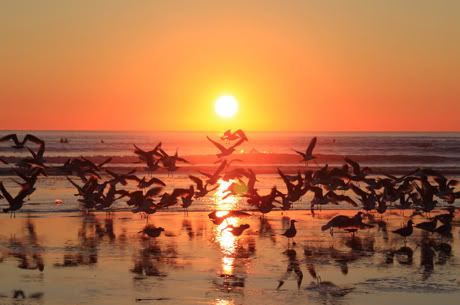Giant Sea Stacks and Myself, Rialto Beach, Olympic National Park, WA
Rialto Beach at Olympic National Park, a UNESCO World Heritage site, is not your typical beach. This is a wild stretch of coast more popular for backcountry hiking and camping.
Coastal Forest and Ocean Beach @ Rialto Beach
Rialto Beach is just a few miles West from where we stayed at the town of Forks. Our drive from Forks to Rialto Beach was very beautiful. The road winds between a thick canopy of pine and maple forest and ends at the beach. Rialto Beach beach starts at the mouth of the Quillayute River.
Mouth of Quillayute River and Forest Capped James Island, Rialto Beach
From the mouth of Quillayute River, the beach extends about 4 miles, bounded by sea stacks, tidepools and the Pacific Ocean on the West, and by piles of driftwood, ghost forest and the pine and maple forest wall to the East.
Driftwood (above) and Ghost Forest ( Below)
While walking on this coastal strip, we saw several white eagles perched on top of the tree, or flying above us,
or perched on top of the rocks in the middle of the sea ready to fish.
How Many Bald Eagles do you see here?
Among the sea stacks, Hole-in-the-Wall is one of the most interesting, which is about 1.5- 2 miles from Rialto's Beach Parking lot, and within an earshot to the camp sites. Camping right next to the ocean in the midst of pine and maple forest and the sea stacks in front of you is definitely a one of a kind experience.
Hikers at Hole-in-the-Wall
Even in the middle of summer however, it can be very windy, cold and chilly camping and exploring here at Rialto Beach. It is good to bring the best of your camping equipment to protect yourself from the elements and enjoy fully the wonderful gift of nature in this area. Vacation becomes more fun for me if it is about actively exploring the great outdoors, without sacrificing comfort to really optimize the fun. Camping Gear Outlet is one of the wonderful places you can look for supplies for your outdoor needs online.
Hole- in- the- Wall
Hole-in-the-Wall is a natural arch that was pierced through a cobble-stoned rock by centuries of surf and wind. At high tide, hikers can not cross this arch, instead they must climb the rock to continue up North. We did our homework the day before coming here, we checked the time of low tide which was 10:00 am. The day prior to this we reached Olympic Peninsula at past low tide, therefore, we spent our time doing more land hiking at Moments In Time and Sol Duc Falls, before retiring to Forks. We woke up early enough and had early breakfast to reach Hole in the Wall at low tide. Dining at Forks was fun, most restaurants says something about "Twilight" :), but surely, all those "Twilight" meals helped us in giving energy for our physical activities.
While walking, we saw a lot of starfish sticking to the rocks pounded by the waves, however, as we got closer to Hole in the Wall, there were no more pounding waves and the tide pool was exposed. We saw hundreds of starfish, anemone, and other shells cleaving to kelp-laden tide pools.
Orange and Purple Starfish (top 2 pictures, by KTL),
Anemone and underside of Starfish ( bottom 2 pictures, by Betchai )
Starfish feeds on clams, oysters and mussels, through their mouth which is the middle opening on their underside ( bottom right picture above). Starfish don't eat shellfish with their shells on, but rather, they use their powerful suction cups on their legs to open the shell of their prey. When the shell is wide open and meat is exposed, star fish push their stomach out through their mouth and digest it. Star fish are scavengers and hunters that clean up the bottom of the ocean floor, eating some fish-killing algae. Most of the starfish we saw are not by themselves, but they are cleaving to each other and on the rocks.
Group of Starfish
Grouping together is one of the starfish defense mechanisms to protect themselves from the pounding waves as they can easily be washed off shore by the very strong waves. As the star fish cleave together, their strength multiplies exponentially that they will be able to hold on together defying the pounding waves that crash on them. The star fish exemplifies best the quote, "Together we stand, divided we fall."
Someone from my Facebook friends left me a comment if the picture above is real, I think we had presumed before that this question may be asked, that's why probably we have different attempts to take this picture with the ocean scenery to say, yes, they are real.
the same group of starfish in the last starfish group picture above
Since I have been awakened to the magnificent beauty and power of nature preserved in National Parks during my first National Park hike at the Grand Canyon's South Kaibab trail last thanksgiving 2006, I had made a list of our big trips exploring the 58 US National Parks. Olympic National Park was one of those that were high in my priority. Olympic National Park is not just about these ancient sea stacks and the abundance of ocean wildlife, is not just about the glacier-capped mountain peaks, not just about the amazing and out-of-this-world rain forest, not just about its roaring waterfalls, but Olympic National Park is the embodiment of a stunning variety of landscapes, plants and animal life. I am glad I came, I won't be surprised if one day I will find myself here again even without completing all the 58 US National Parks yet.











































